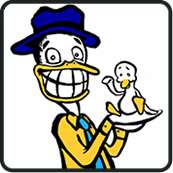As we hope you already know, hockey is a game played on ice, and the players all wear skates. The hockey rink is big--200 feet long and 85 feet wide--and the ice surface has painted lines on it to indicate the various zones (which you'll read about in another article). The most important lines are the red line (which cuts the ice in half) and the blue lines (which are parallel to the red line and are painted 73' from each end of the rink).
Each team "owns" one side of the ice, and the area behind a team's blue line is called its defending zone. The area behind the opposing team's blue line is called the attacking zone. The area between the two blue lines is called the neutral zone. The bottom of the USA Hockey web page has a clear picture of a hockey rink.
So what's the point of a hockey game? Each team has a goal net at its end of the ice. The point of hockey is to score more goals in your opponents' net than they do in yours. It's just like soccer, basketball, and most other team sports. Just like soccer, tie games are allowed in hockey.
Each game consists of three periods of 20 minutes each. The players get about 15 minutes of rest between periods. Hockey tends to be a low scoring game; two to three goals is often enough to win, and many games have finals scores of 1 to 0.
SoYouWanna know more? Check out our full-length article SYW learn the basics of hockey?

